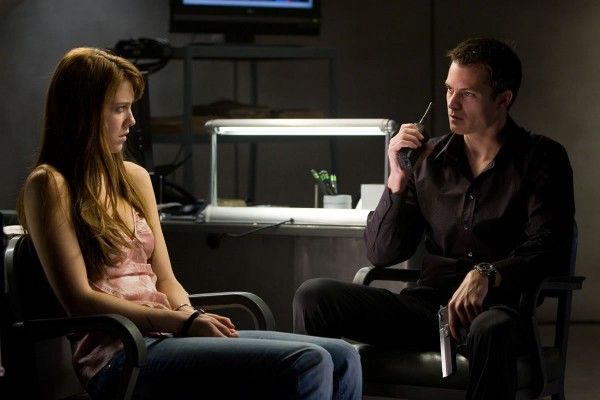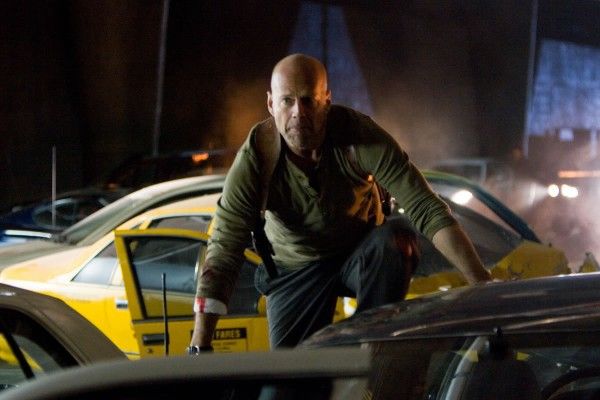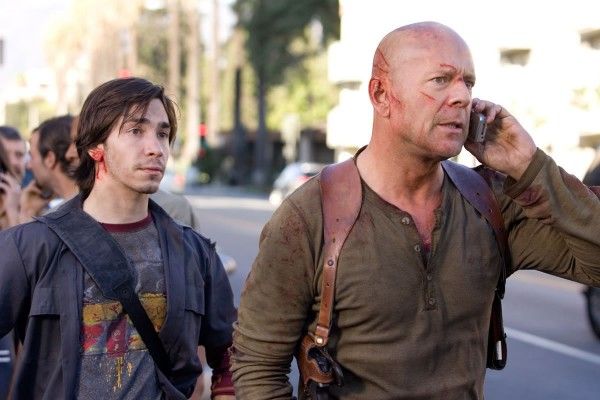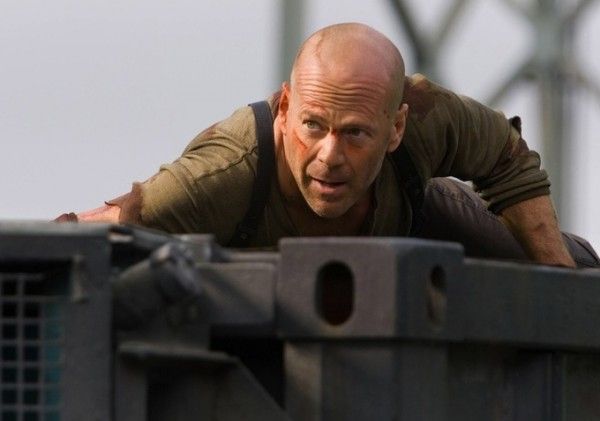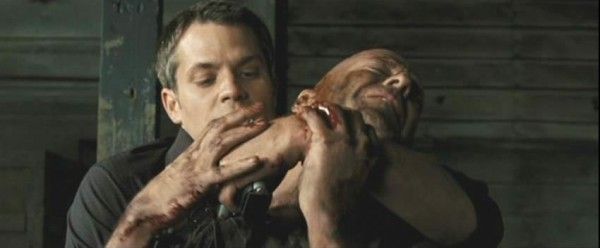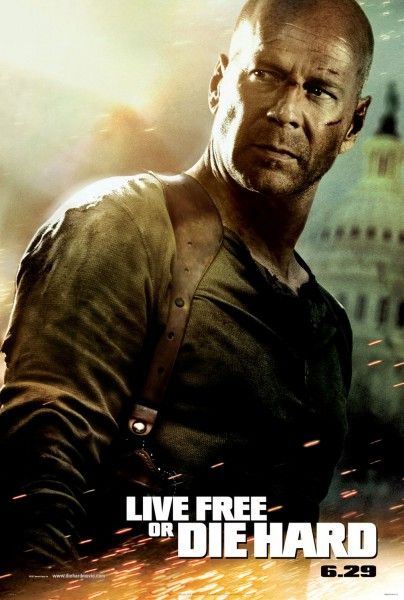[With A Good Day to Die Hard set to open this Thursday, we'll be taking a look back at the first four Die Hard movies. These reviews will contain spoilers since the movies have been out for years. Click on the respective links for my look back at Die Hard, Die Hard 2, and Die Hard with a Vengeance.]
The longest gap between Die Hard movies was the 12 years between Die Hard with a Vengeance (1995) and Live Free or Die Hard (2007). In the interim, the world had drastically changed most notably because of 9/11 and developments in communications technology. No longer could terrorism be casually mentioned as a guise for a heist, and John McClane (Bruce Willis) wouldn't be running around looking for the nearest pay phone. As Live Free villain Thomas Gabriel (Timothy Olyphant) says to McClane, "You're a Timex watch in a digital age." It's a crappy metaphor since Timex has been making digital watches for decades, but the sentiment is noteworthy: Is John McClane a relic? The question doesn't really matter since Live Free or Die Hard barely qualifies as a Die Hard film, especially with Willis' bored performance and the PG-13 rating. Instead, Live Free is best explored as the way a Die Hard movie would approach terrorism if a Die Hard film was directed by a hand-tied fan who didn't understand the essence of the franchise.
As we saw in Die Hard with a Vengeance, it doesn't hurt to give McClane a partner, but the personality of that partner is crucial. Live Free or Die Hard has McClane carting around hacker Matt Farrell (Justin Long), whose life is in danger after he unintentionally contributed a world-destroying code to Gabriel. Gabriel's plan is to have a "fire sale" where he controls communications, utilities, transportation, and pretty much anything else he wants because computers are magic. As the world starts crumbling around them, McClane and a reluctant Farrell decide to go after Gabriel, and save the day. However, Gabriel gets an ace-in-the-hole by kidnapping McClane's daughter/plot-device, Lucy (Mary Elizabeth Winstead).
Live Free or Die Hard has a number of key misunderstandings when it comes to what John McClane does. The top of the list is "John McClane Does Not Save the World". Part of the character's charm is that he's "The Little Guy". He gets put in a tight situation and has to scrap his way out of it. Even when he seeks out the problem like in Die Hard 2, he's still stuck in the confines of the airport, and he's out to save hostages. Even Die Hard with a Vengeance doesn't have him saving all of New York City. When the canvas gets too large, McClane doesn't matter because he's clearly not the only one who can save the day. He's trapped in Die Hard, Stuart is watching the airport in Die Hard 2, and he's selected by Simon in Die Hard with a Vengeance. In Live Free or Die Hard, it looks like every other law enforcement person in the country decided to say "Fuck it. It's the Fourth of July weekend, and my grill isn't computer-operated. Who wants hot dogs?"
The large canvas also lessens the urgency of the picture since McClane and Farrell are mostly on a road trip, so the film is taking place over the course of days rather than hours. Even when the first three Die Hard movies aren't having an action scene, there's always intensity. McClane has to keep running or driving fast. Live Free or Die Hard involves leisurely trips through the countryside where McClane explains that he feels obligated to do the right thing even though his heroism has pushed his family away. He's picked his life back up from With a Vengeance, so it's tough to believe his family would be driven away by heroism.
It also can't be his personality since the intensity has all but died away. Willis seems mostly disinterested in reprising his famous role. It takes about 45 minutes for McClane to start feeling like McClane again as he survives a brutal action scene, laughs in the face of death, and starts talking to himself. Then Farrell interrupts by saying how McClane should probably go to the hospital, but McClane shrugs it off so they can keep pursuing Gabriel. Willis occasionally comes back to life, but this a far more subdued McClane, which isn't really McClane at all.
The quieter McClane puts all of the comic relief on Long's shoulder when usually Willis would be the one doing the quips. But director Len Wiseman doesn't seem to see Live Free or Die Hard as John McClane's movie as much as it's about a fan's perception of John McClane. McClane has taken on the status of an idol in the popular culture, and Live Free wants us to identify with the worshiper, Farrell. We get to hang out with John McClane! Isn't that cool? Not really. We don't want to be the guy who gets to hang out with John McClane. We want to be John McClane. The fanboyism deepens when Kevin Smith comes along as mega-hacker "Warlock". Aside from playing into the total cliché of computer nerds all live in their mother's basement, we're not watching a character, but a nerd who won a role in a movie.
In addition to not really putting the focus on McClane, Wiseman doesn't have much of a villain in Gabriel simply because Gabriel is working from mixed motives. The dichotomy of a tech-savvy villain against the old-school McClane would work except we get it non-stop from McClane's relationship with the tech-savvy Farrell. Therefore, Gabriel has nothing left except being torn between being a terrorist and being a crook. The franchise is at a crossroads, Live Free or Die Hard wants to take both paths, and it ends up going nowhere even though Olyphant does his best to bring some life to his muddled character.
There are no terrorists in the first three Die Hard movies. There are thieves and kidnappers posing as or behaving like terrorists, but there's no ideology. However, their actions and what they provide as entertainment would be highly-questionable in a post-9/11 world. In Die Hard, a giant explosion in a tower is referred to as "property damage". In Die Hard 2, an airport is taken over, and the bad guy crashes a plane to prove a point. In Die Hard with a Vengeance, bombs go off throughout New York City. The curious thing about With a Vengeance is that there had been a foreign attack on U.S. soil by that point, and it happened in NYC. The 1993 World Trade Center bombing was meant to bring down the tower, but it only managed to kill six people although it injured thousands of others. But when it's brought up in With a Vengeance, Detective Walsh tells Simon, "You know what a mess that was." No character in a 2003 movie could have gotten away with calling 9/11 "a mess."
Terrorism and government incompetence were very real in 2007. As Farrell tells McClane, "It took FEMA five days to get water to the Superdome." So government isn't going to save us from the world's greatest hacker/thief/pseudo-terrorist. You can feel the hesitance of Wiseman and screenwriter Mark Bomback to make the villain a true terrorist, but they also want to make a real Die Hard movie, so the bad guy has to be in it for the money. Live Free wants to have it both ways, and it leaves Gabriel feeling like a villain in search of a motive.
Even though I don't think he's a particularly good director, I feel some sympathy for Wiseman because you can see that he lacks the freedom to make a true Die Hard movie, but he's still partially to blame for contradicting his own film's values. There's nothing he could have done about a studio mandate for a PG-13 movie. People are killed in bloodless shootouts, and the word "fuck" isn't allowed even though it's part of McClane's signature catchphrase. But the PG-13 doesn't prevent Wiseman from harkening to the old-school values of his protagonist. Rather than rely mostly on practical effects and stunt work, Wiseman throws digital cars at McClane and has him jumping off of fighter jets. The parkour henchman would be a nice flourish if other action films hadn't already been doing it. There's also the ridiculous fight against Mai Linh (Maggie Q) who gets rammed by a car three times before she dies by plummeting down an elevator shaft. Remember when McClane dispatched a henchman by falling down a flight of stairs?
More infuriating is the final confrontation with Gabriel makes the helicopter takedown in With a Vengeance look like a masterful resolution. First, Gabriel says McClane's tombstone will read, "Always in the wrong place at the wrong time," even though that hasn't been McClane's relationship to Gabriel. It's McClane's life in the first two Die Hard movies, so that's the writer talking and not the character. Furthermore, Gabriel holds McClane hostage in the dumbest way possible: rather than putting the gun to McClane's head or back, Gabriel points the gun into McClane's chest, which means he's also pointing the gun at himself. No one has held a hostage like this or will ever hold a hostage like this. And then McClane sacrifices himself with a trademark line smothered by the censors as we hear, "Yippie-ki-yay, mother-"*gunshot*.
For all of its many, many flaws, I don't hate Live Free or Die Hard as much as I'm simply bored by it. My lack of hatred comes from the fact that Wiseman feels like a fan who's doing his best to make what he thinks is a Die Hard movie. Sadly, he lacks the talent and the resources to make that vision come to life. It's a film of sad ironies and missed opportunities, but it's essential in illustrating the Die Hard franchise because it shows what not to do. There's value in Live Free or Die Hard. It's just not the value the movie would like to have.
Rating: D
[Tonight: My review of A Good Day to Die Hard]


